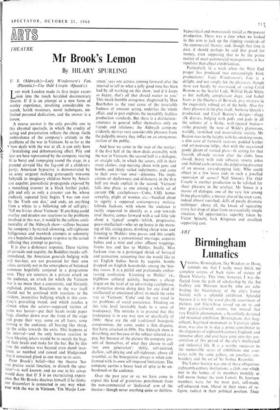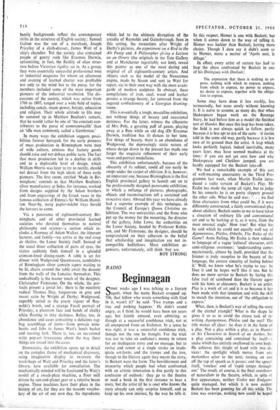Birmingham Lunatics
ART VISITING Birmingham, like Windsor or Hove, reminds me that I really must finish my complete corpus of back views of statues of Queen Victoria. This time, however, I was de- flected from the path of scholarship by the Art Gallery and Museum near-by who are cele- brating the bicentenary of the city's Lunar Society with a splendid exhibition. Splendid because it is not the usual ghastly assortment of pictures and bric-à-brac tossed up on to and into gravy-coloured rooms, but instead that rare English phenomenon, a beautifully designed and mounted exhibition. Birmingham, that mag- nificent, begrimed monument to Victorian splen- dour, was also in its day a prime contributor to the elegancies of eighteenth-century England; and immense effort and cost have gone into this pre- sentation of this period of the city's intellectual and industrial life. It is a worthy successor to the memorable series of exhibitions one asso- ciates with the same gallery, on jewellery, em- broidery and the art of Sir Joshua Reynolds.
The Lunar Society was one of those ubiquitous eighteenth-century institutions, a club, one which met in the homes of its members monthly at full moon (hence the term Lunar). Its fourteen members were, for the most part, self-made, self-educated men, liberal in their views of re- ligion, radical in their political position. Their family backgrounds reflect the contemporary shifts in the structure of English society: Samuel Gallon was the son of a merchant, Joseph Priestley of a cloth-dresser, James Watt of a ship's chandler. Yet the society also contained people of gentry rank like Erasmus Darwin, epitomising, in fact, the fluidity of class struc- ture before Victorian rigidity set in. As a group, they were essentially successful professional men or industrial magnates for whom an afternoon and evening of learned chatter was profitable not only to the mind but to the purse, for the members included some of the most important pioneers of the industrial revolution. The dis- cussions of the society, which was active from 1766 to 1807, ranged over a wide field of topics, including canals, steam power, botany, education and religion. Their whole attitude to life may be summed up in Matthew Boulton's remark, that he would rather be one of 'the constant con- tributors to the purse of commonwealth' than an 'idle man commonly called a Gentleman.'
In many ways the exhibition suggests possi- bilities forever betrayed, for the early pioneers of mass production in Birmingham were men of wide culture, anxious that factory goods should raise and not debase public taste. The fact that mass production led to a decline in skills and to a deplorable level of design, which William Morris was later to try to rectify, should not detract from the high ideals of these early pioneers. The first room, entitled `Made in Bir- mingham,' reminds us that Matthew Boulton's silver manufactory at Soho, for instance, worked from designs supplied by the Adam brothers and from engravings of the Greek vases in the famous collection of Emma's Sir William Hamil- ton. Near-by, nasty papier-miché trays herald the horrors to come.
Via a panorama of eighteenth-century Bir- mingham, and of other provincial learned societies who devoted themselves to natural philosophy and science—a section which in- cludes a Romney of Adam Walker, the itinerant lecturer, and family—we arrive at the real coup de thedtre, the Lunar Society itself. Instead of the usual drear collection of pairs of eyes, the visitor suddenly finds himself in a splendid crimson-lined dining-room. A table is set for dinner with Wedgwood Queensware, candelabra of Birmingham silver contain tapers waiting to be lit, chairs around the table await the descent from the walls of the Lunatics themselves. This undoubtedly is the master touch of the designer, Christopher Firmstone. On the whole, the por- traits present a jovial lot : there is the eccentric radical Thomas Day, languorous in grey and russet satin by Wright of Derby; Wedgwood, superbly suited to the crusty vigour of Rey- nolds's brush, and a strange Fuseli portrait of Priestley, a phantom face and hands of chalky white floating in inky darkness. Relics, too, in abundance and cases containing a delicious rag- bag assemblage of items—from prosaic note- books and fobs to James Watt's lunch basket and toasting fork. There is, too, an occasional witty pop-art irreverence about the way these things are tossed into the cases.
Downstairs, the exhibition opens up in detail on the complex theme of mechanical discovery, using imaginative display to re-create the workr.hops of Watt and Priestley and the latter's library, here available for consultation. The mechanically-minded will be fascinated by Watt's model of a swash-plate machine, a flour mill driven by sun-and-planet gear or a rotative beam engine. These machines have their place in the Wits:pry, of art,.for they. are the nascent vocabu- lary of the art of our own day, the ingredients which led to the ultimate disruption of the arcadia of Reynolds and Gainsborough. Seen in this setting, the mezzotints after Wright of Derby's pictures, An experiment on a Bird in the Air Pump and A Philosopher giving a Lecture on an Orrery (the originals in the Tate Gallery and at Manchester regrettably not lent), reveal this painter as one of the most daring and original of all eighteenth-century artists. And objects such as the model of the Newcomen engine, made by Sisson and sent to Watt for repair, vie in their own way with the most avant- garde of modern sculpture. In abstract, these compilations of iron, steel, wood and leather possess a strange beauty, far removed from the sugared confectionery of a Georgian drawing- room.
This is essentially a tough, masculine exhibition, not without things of beauty and occasional dottiness. For the latter, witness the silhouette of Mrs Pole, a gyrating puff of gauze, playing away at a flute while an old dog (Dr Erasmus Darwin, tradition has it) dances to her tune. For things of beauty, there is an abundance of Wedgwood, the depressingly static nature of . whose design down to the present has made one forget the exquisite refinement of their early vases and portrait medallions.
This exhibition unfortunately, because of the obscurity of its subject, could all too easily be swept under the carpet of oblivion. It is, however, an important one, because Birmingham is the first English provincial gallery to launch odt on to the professionally designed panoramic exhibition, in which a melange of pictures, photographs, objects and reconstructions tell a sustained and evocative story. Abroad this year we have already had a supreme example of this technique, in the Council of Europe's Queen Christina ex- hibition. The two universities and the firms who put up the money for the mounting, the director of the gallery, John Lowe, the authorities on the Lunar Society, headed by Professor Robin- son, and Mr Firmstone, the designer, should be congratulated on their adhesion to the belief that scholarship and imagination are not in- compatible bedfellows. Most exhibition or- ganisers, unfortunately, still think they are.
ROY STRONG



































 Previous page
Previous page